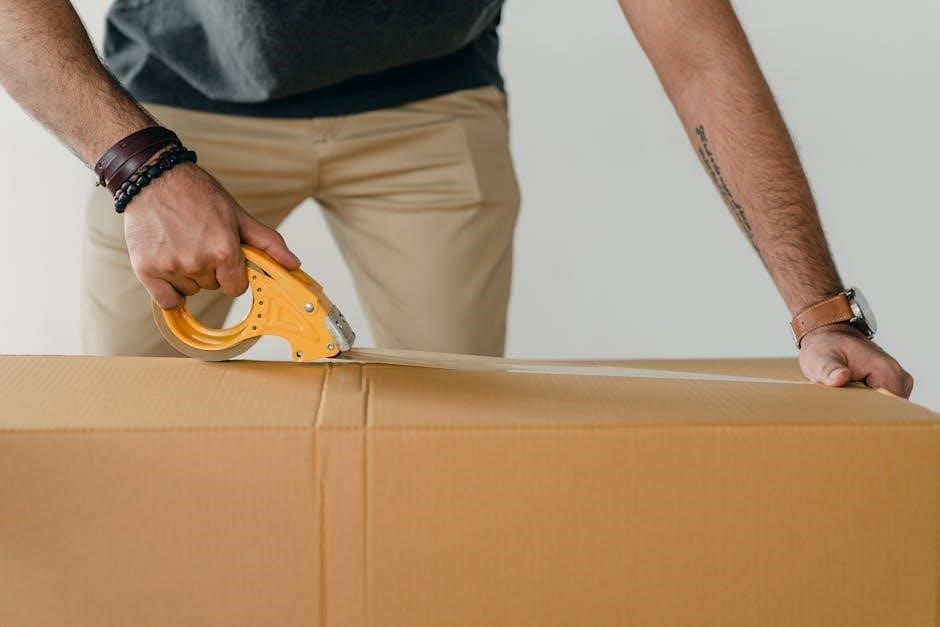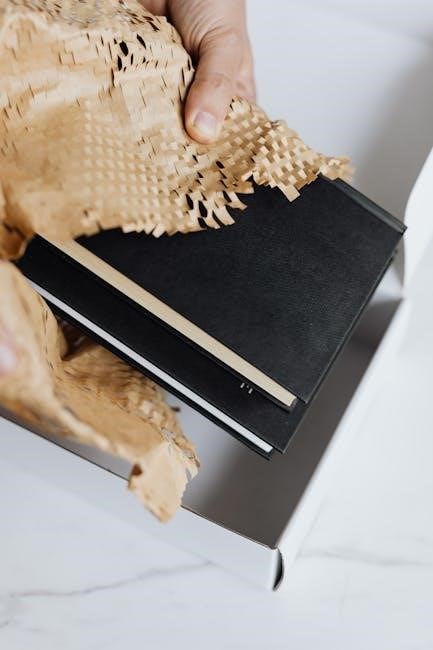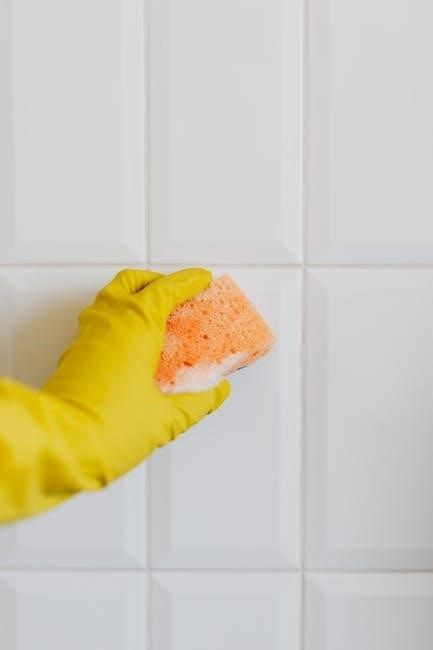Manual self-cleaning litter boxes offer a practical‚ cost-effective solution for cat owners‚ combining efficiency with eco-friendly benefits. They appeal to those seeking a balance between convenience and sustainability.
1.1 What is a Manual Self-Cleaning Litter Box?
A manual self-cleaning litter box is a cost-effective‚ eco-friendly option designed to simplify cat waste management. It requires user interaction‚ such as scooping or separating waste‚ but reduces litter usage and maintenance effort. These boxes often feature compartments or trays for waste collection‚ making cleanup easier. They are a practical choice for pet owners seeking a balance between convenience and affordability without relying on automated systems.
1.2 How Does it Differ from Automatic Models?
Manual self-cleaning litter boxes differ from automatic models by requiring user involvement for waste removal. Unlike automatic models that use sensors and motors‚ manual ones rely on simple mechanisms like scoops or trays. This makes them more affordable and quieter. They also consume less energy‚ appealing to eco-conscious owners. While automatic models offer hands-free convenience‚ manual boxes provide a cost-effective‚ low-tech alternative for those who prefer direct control over cleaning.

How Manual Self-Cleaning Litter Boxes Work
These litter boxes use simple mechanisms like trays or rakes to separate waste from clean litter‚ requiring users to manually remove waste‚ often through a scoop or drawer system.
2.1 Mechanisms and Features
Manual self-cleaning litter boxes often feature removable trays or compartments that separate waste from clean litter. Some models include rakes or scoops for easy waste removal‚ while others use layered systems to trap odor and moisture. Filters or carbon layers may be included to reduce smells. These designs emphasize simplicity and efficiency‚ allowing users to maintain hygiene without complex automation. They are typically quieter and more energy-efficient than automatic models‚ catering to eco-conscious pet owners.
2.2 Process of Waste Separation
Manual self-cleaning litter boxes separate waste through simple‚ user-activated mechanisms. Typically‚ a rake or scoop is used to remove solid waste‚ while liquid waste is absorbed by litter or filtered layers. Some models feature compartments that isolate waste for easy disposal. This process ensures clean litter remains‚ reducing odor and mess. Regular maintenance is required‚ but the design makes it efficient and straightforward‚ keeping the litter box hygienic for your cat.
2.3 User Interaction Required
Manual self-cleaning litter boxes require periodic user involvement to maintain functionality. Owners must regularly empty the waste compartment‚ monitor litter levels‚ and ensure proper operation. While automated models handle much of the work‚ occasional scooping or raking may still be needed. Users should also clean the box thoroughly every few weeks to prevent odor buildup. Despite these tasks‚ the system remains efficient and reduces daily maintenance compared to traditional litter boxes.

Benefits of Using a Manual Self-Cleaning Litter Box
Manual self-cleaning litter boxes reduce odor‚ save time‚ and minimize litter waste. They are cost-effective‚ eco-friendly‚ and suitable for multiple cats‚ offering a practical solution for pet owners.
3.1 Convenience and Time-Saving
Manual self-cleaning litter boxes simplify daily maintenance by reducing the frequency of scooping. They separate waste efficiently‚ allowing for quicker cleanups. This design minimizes odor and mess‚ saving time for busy pet owners. With less frequent emptying required‚ these boxes offer a practical solution for maintaining a clean environment without constant supervision‚ making them ideal for those seeking convenience.
3.2 Reduced Litter Waste
Manual self-cleaning litter boxes are designed to minimize litter waste by efficiently separating and containing solid waste. This reduces the need for frequent complete litter changes‚ lowering overall litter consumption. By trapping waste in a designated area‚ these boxes prevent excess litter from being thrown away‚ making them an eco-friendly choice for pet owners who aim to reduce their environmental footprint while maintaining a clean and hygienic space for their cats.
3.3 Cost-Effectiveness
Manual self-cleaning litter boxes are a budget-friendly option for cat owners‚ offering long-term savings. While initial purchase prices range from $70 to $600‚ these boxes reduce litter waste and extend the time between full litter changes. This results in lower ongoing costs for litter and maintenance. Over time‚ the efficiency of these systems makes them a cost-effective choice for pet owners seeking to balance affordability with functionality and hygiene for their feline companions.
3.4 Odor Control
Manual self-cleaning litter boxes are designed to minimize unpleasant odors effectively. They often feature mechanisms that absorb urine and dehydrate solid waste‚ reducing smells. Some models include hooded covers to contain odors and prevent litter from spilling out. Regular maintenance‚ such as emptying waste compartments‚ ensures freshness. These systems provide a cleaner environment for both cats and owners‚ making them a practical choice for odor control without the need for frequent full litter changes.

Things to Consider Before Purchasing
When choosing a manual self-cleaning litter box‚ consider budget‚ number of cats‚ space‚ and maintenance needs. These factors ensure the right fit for your lifestyle and preferences.
4.1 Budget and Price Range
Manual self-cleaning litter boxes vary in price‚ ranging from $70 to $600‚ offering options for different budgets. While cheaper models provide basic functionality‚ pricier ones include advanced features like odor control and larger capacities. Considering your budget ensures you find a model that meets your needs without overspending. Researching customer reviews helps identify value for money and avoid overpriced options.
4.2 Number of Cats and Usage
The number of cats in your household significantly impacts the choice of a manual self-cleaning litter box. High-capacity models are ideal for multiple cats‚ ensuring efficient waste management. Usage patterns‚ such as frequency and waste volume‚ also influence the suitability of a litter box. Larger or multi-cat households may require more durable and spacious options to prevent overcrowding and maintain hygiene. Consider these factors to select a model that meets your cats’ needs effectively.
4.3 Space and Size Requirements
Space and size are crucial considerations for manual self-cleaning litter boxes. Measure your available area to ensure the litter box fits comfortably. Compact models are ideal for small apartments‚ while larger units suit multi-cat households. Practical designs often balance size with functionality‚ ensuring your cats have ample space to move. Consider the litter box’s dimensions and how it will integrate into your home’s layout for optimal placement and accessibility.
4.4 Maintenance and Cleaning Frequency
Maintenance and cleaning frequency are vital for manual self-cleaning litter boxes. Regular scooping is essential to prevent odor buildup and bacterial growth. Empty the waste compartment daily and refresh litter as needed. Some models require weekly deep cleans‚ while others offer reusable filters to reduce dust. Consistent upkeep ensures hygiene and prolongs the product’s lifespan. A well-maintained litter box keeps your cat healthy and your home odor-free.

How to Choose the Right Manual Self-Cleaning Litter Box
Selecting the right manual self-cleaning litter box involves considering size‚ cat preferences‚ and features like odor control and waste separation. Compare models to find the best fit for your needs and budget.
5;1 Key Features to Look For
When selecting a manual self-cleaning litter box‚ prioritize features like efficient waste separation‚ odor control‚ durability‚ and ease of cleaning. Ensure it suits your cat’s size and preferences‚ with a design that minimizes dust and mess. Some models offer additional benefits such as eco-friendly options or space-saving designs‚ which can enhance both functionality and convenience for pet owners.
5.2 Reading Reviews and Ratings
Reading reviews and ratings is crucial for selecting the best manual self-cleaning litter box. Pay attention to feedback on ease of use‚ odor control‚ and durability. Look for mentions of common issues like cleaning pauses or design flaws. High-rated models often highlight efficiency and cost-effectiveness‚ while lower ratings may indicate reliability problems. Prioritize reviews from long-term users to gain insights into performance over time. This ensures you make an informed decision tailored to your needs.
5.3 Comparing Different Models
When comparing manual self-cleaning litter box models‚ consider price‚ features‚ and user reviews. Models range from $70 to $600‚ with varying functionalities. Some users praise efficient waste separation‚ while others note design flaws. Popular models like the Litter-Robot 4 are favored for multiple cats but can be costly. Reviews highlight noise issues and cat acceptance. Prioritize your needs‚ such as budget‚ space‚ and odor control‚ to find the best fit for your household.

Setting Up and Using a Manual Self-Cleaning Litter Box
Setting up a manual self-cleaning litter box involves initial assembly and placement. Daily maintenance ensures efficiency‚ while training your cat to use it smoothly completes the process.
6.1 Initial Setup and Assembly
Setting up a manual self-cleaning litter box begins with unboxing and reading the user manual. Place the box in a quiet‚ accessible location for your cat. Assemble any detachable parts‚ such as trays or sifters‚ following the manufacturer’s instructions. Fill the box with the recommended litter type and level. Ensure your cat can easily enter and exit. Double-check all components are securely fitted before introducing your cat to its new litter box.
6.2 Training Your Cat to Use It
Introduce your cat gradually to the manual self-cleaning litter box by placing it alongside their current one. Encourage exploration with treats or toys. Once familiar‚ transition fully by replacing the old box. Monitor their behavior to ensure adaptation. Supervise initial use to address any reluctance. Be patient‚ as some cats may need time to adjust to the new design and mechanism. Consistency and positive reinforcement aid a smooth transition.
6.3 Daily Maintenance Tips
Regularly empty the waste drawer and refill litter as needed. Check the litter level to ensure optimal performance. Clean the box with mild detergent weekly to prevent odor buildup. Inspect for blockages or wear. Monitor your cat’s behavior to ensure they’re using the box correctly. Replace filters or absorbents as recommended. Maintain a clean environment to encourage proper use and hygiene. Consistent upkeep ensures longevity and effectiveness of the manual self-cleaning litter box.

Common Issues and Troubleshooting
Common issues include technical malfunctions‚ persistent odors‚ and cats refusing to use the box. Troubleshooting involves checking mechanisms‚ ensuring regular cleaning‚ and verifying proper size suitability.
7.1 Technical Malfunctions
Technical malfunctions in manual self-cleaning litter boxes often involve issues like mechanism jams or faulty waste separation systems. These problems can disrupt the litter box’s functionality and require immediate attention. Common causes include improper assembly‚ excessive litter levels‚ or debris clogging the components. Regular maintenance‚ such as cleaning moving parts and ensuring correct litter type usage‚ can help prevent these issues. Addressing malfunctions promptly ensures the litter box operates smoothly and effectively.
7.2 Odor Problems
Odor issues in manual self-cleaning litter boxes often arise from infrequent cleaning or improper litter usage. If waste isn’t removed regularly‚ smells can intensify‚ making the environment unpleasant. Using high-quality‚ odor-absorbing litter and ensuring proper ventilation can help mitigate these issues. Regular scooping and refilling litter as needed are essential to maintain freshness and prevent odor buildup.
7.3 Cats Refusing to Use the Litter Box
Cats may refuse to use a manual self-cleaning litter box due to noise‚ design preferences‚ or aversion to change. Some cats dislike the mechanism’s sound or the texture of the litter. Others may find the box too small or uncomfortable. Gradually introducing the new litter box alongside their traditional one can help ease the transition. If resistance persists‚ consulting a vet or behaviorist may be necessary to address underlying issues.
Manual vs. Automatic Self-Cleaning Litter Boxes
Manual models are cost-effective and require user involvement‚ while automatic ones offer hands-off convenience at a higher price‚ differing in maintenance‚ automation‚ and reliability.
8.1 Pros and Cons of Each Type
Manual self-cleaning litter boxes are budget-friendly and eco-conscious‚ requiring minimal energy use but needing daily scooping. Automatic models offer convenience‚ handling waste with less effort‚ but are pricier and may malfunction. Manual boxes are quieter and simpler‚ while automatic ones suit busy owners or multi-cat homes but may frighten cats with noise. Each type has trade-offs in cost‚ maintenance‚ and functionality‚ catering to different lifestyles and preferences.
8.2 Which is Better for Multiple Cats?
For multiple cats‚ automatic self-cleaning litter boxes are generally more efficient‚ reducing odor and the frequency of cleaning. They handle higher usage better but can be noisier and more expensive. Manual models are cost-effective and quieter but require daily maintenance‚ which may be less practical for large households. Automatic boxes are ideal for busy homes‚ while manual ones suit smaller spaces or those preferring a budget-friendly option.
8.3 Noise Levels and Cat Preference
Manual self-cleaning litter boxes are typically quieter‚ appealing to noise-sensitive cats‚ while automatic models can startle cats with their operational sounds. Some cats prefer the privacy of manual boxes‚ while others adjust well to automatic ones. Choosing the right type depends on a cat’s personality and tolerance for noise‚ ensuring their comfort and willingness to use the litter box consistently without stress or avoidance behaviors.

Eco-Friendly and Sustainable Options
Eco-friendly manual self-cleaning litter boxes emphasize sustainable materials and reduced waste. They often use biodegradable or recyclable components‚ promoting environmental responsibility while maintaining functionality and efficiency for cat owners.
9.1 Eco-Friendly Litter Options
Eco-friendly litter options for manual self-cleaning litter boxes include silica‚ recycled paper‚ and biodegradable materials. These choices reduce environmental impact while maintaining effectiveness. Biodegradable litters‚ like those made from natural fibers‚ decompose easily‚ minimizing waste. Additionally‚ some litters are free from harmful chemicals‚ promoting a healthier environment for both cats and the planet. These options align with sustainable living practices‚ offering a guilt-free solution for eco-conscious pet owners who prioritize environmental responsibility without compromising on performance or convenience.
9.2 Energy Efficiency
Manual self-cleaning litter boxes are inherently energy-efficient as they eliminate the need for electricity. Unlike automatic models‚ they rely on manual operation‚ reducing power consumption and energy costs. This eco-conscious design minimizes environmental impact while maintaining functionality. By avoiding motorized components‚ these litter boxes also reduce noise and mechanical failures‚ making them a sustainable and reliable choice for environmentally aware pet owners seeking to lower their carbon footprint without sacrificing convenience.
9.3 Reducing Waste
Manual self-cleaning litter boxes help reduce waste by efficiently separating and storing waste‚ minimizing the amount of litter used over time. They often feature compact designs that optimize litter usage‚ reducing the frequency of full litter changes. Additionally‚ eco-friendly litter options like biodegradable or compostable varieties can further minimize waste‚ aligning with sustainable practices and reducing environmental impact while maintaining cleanliness and hygiene for your cat.

Safety Considerations
Manual self-cleaning litter boxes prioritize cat safety‚ reducing risks of injury from moving parts. Durable designs prevent tipping‚ ensuring stability and secure use for pets.
10.1 Ensuring Cat Safety
Manual self-cleaning litter boxes are designed with cat safety in mind. They typically feature sturdy‚ non-toxic materials and smooth surfaces to prevent injuries. Ensuring the box is placed in a stable‚ secure location is crucial‚ as tipping can pose risks. Additionally‚ regular inspections for wear and tear help maintain a safe environment. Supervising your cat during initial use can also prevent any potential accidents‚ ensuring a comfortable and secure experience for your pet.
10.2 Preventing Accidents
Preventing accidents with manual self-cleaning litter boxes involves proper placement and maintenance. Position the box on a stable‚ non-slip surface to avoid tipping. Regularly check for wear and tear‚ ensuring all parts function smoothly. Supervising your cat during initial use can help prevent mishaps. Additionally‚ keeping the area around the litter box clear of clutter reduces tripping hazards. These steps ensure a safe and stress-free experience for both you and your cat.
10.4 Maintenance for Longevity
Regular maintenance is crucial for extending the life of manual self-cleaning litter boxes. Clean the box thoroughly every week‚ paying attention to corners and crevices where debris accumulates. Replace worn-out parts promptly‚ such as scoops or filters. Always follow the manufacturer’s guidelines for disassembly and cleaning. Proper care ensures optimal performance‚ prevents odors‚ and maintains hygiene‚ ultimately benefiting both the cat and the owner.

Are Manual Self-Cleaning Litter Boxes Worth the Investment?
Manual self-cleaning litter boxes offer long-term savings and convenience‚ reducing litter waste and odor‚ making them a practical choice for eco-conscious cat owners seeking efficiency and durability.
11.1 Long-Term Cost Benefits
Manual self-cleaning litter boxes provide significant long-term savings by reducing litter waste and minimizing frequent replacements. Their durable design lowers maintenance costs over time‚ offering a cost-effective solution for cat owners. While initial prices may vary‚ the efficiency and eco-friendly nature of these boxes ensure budget-friendly use in the long run‚ making them a smart investment for pet care.
11.2 Time Efficiency
Manual self-cleaning litter boxes save valuable time by simplifying daily maintenance. Unlike traditional boxes‚ they require less frequent scooping and cleaning‚ thanks to their efficient waste separation mechanisms. This convenience allows cat owners to spend less time on litter duties‚ making them ideal for busy households seeking practical solutions without compromising on hygiene and cat comfort.
11.3 Improved Hygiene
Manual self-cleaning litter boxes enhance hygiene by efficiently separating waste‚ reducing odor‚ and minimizing dust. Their design keeps the litter area cleaner for longer‚ lowering the risk of bacterial growth. This makes them a healthier option for cats and owners alike‚ ensuring a fresher environment with less mess and fewer unpleasant smells.
Manual self-cleaning litter boxes enhance hygiene by efficiently separating waste‚ reducing odor‚ and minimizing dust. Their design keeps the litter area cleaner for longer‚ lowering the risk of bacterial growth. This makes them a healthier option for cats and owners alike‚ ensuring a fresher environment with less mess and fewer unpleasant smells.
12.1 Final Thoughts
Manual self-cleaning litter boxes offer a practical‚ budget-friendly solution for cat owners. They provide convenience‚ reduce waste‚ and promote hygiene without the high cost of automatic models. While they require some user involvement‚ their eco-friendly design and efficiency make them a worthwhile investment for many pet owners. Balancing affordability and performance‚ these litter boxes are a great option for those seeking a reliable and sustainable solution for their feline companions.
12.2 Recommendations
For cat owners seeking a cost-effective solution‚ manual self-cleaning litter boxes are a great choice. They offer a balance of affordability‚ efficiency‚ and eco-friendliness. Opt for models with durable construction and easy-to-use mechanisms. Consider eco-friendly litter options to maximize sustainability. Read reviews to find the best fit for your budget and cat needs. Regular maintenance ensures longevity and hygiene. This practical option is ideal for those who want a reliable‚ low-maintenance litter box without the high cost of automatic models.
